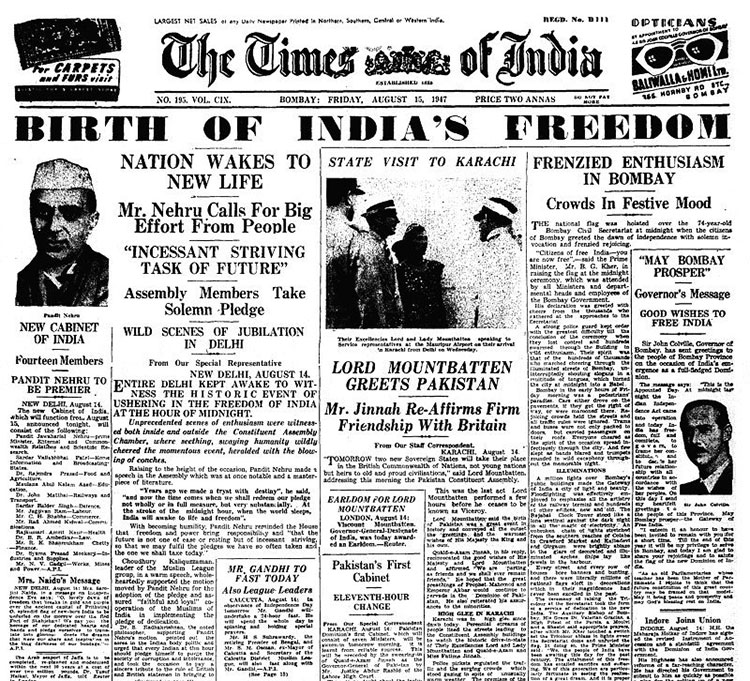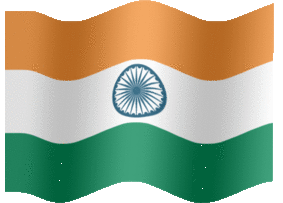Indian Independence Day History
The history of Indian Independence is a long and chequered one. It was on 15th August, 1947, that the country was officially announced to be an independent nation but it took a seemingly endless struggle, the blood, sweat and endurance of popular as well as millions of faceless Indians who fought unitedly to liberate their nation after suffering British reign for about 200 years.
The 1857 Sepoy mutiny was an important landmark in the history of Indian freedom struggle. This act of rebellion on 29th March 1857 by Indian soldiers in the British army at Barrackpore was the result of various factors. Low wages than their British counterparts, racial discrimination, cultural misunderstanding and above all the news (later dismissed as a rumour) that the packings of the latest cartridges were to be greased with cow and pig fat - the combination of all these issues and more led to the violent Barrackpore uprising. Though the British government suppressed the rebellion, the flame of discontent had been kindled. The hanging of Mangal Pandey, a Hindu soldier of the 34th Native Infantry who participated in the oppositive movement and had shot at his sergeant major on the parade ground, further fanned the fire. On 10th May of the same year, enraged Indian soldiers and even common civilians in Meerut joined hands to protest against the maltreatment meted out to some native soldiers and killed many Britishers living in the cantonment. This war took on a big form which was eventually put down by effective British military might.

The next few decades saw various big and small wars being fought against the Empire. Prominent among these were the Battle of Kanpur led by Nana Sahib of Bithur, the Battle of Jhansi by Rani Laxmibai and Tantia Tope, the fight at Arrah in Bihar by the landlord of Jagdishpur Kunwar Singh and the war at Lucknow led by Hazrat Begum. These wars took place in isolated areas of the country and hence, met with little success. But these battles were indicative of the simmering discontent of the Indians against their European rulers and served to keep the torch of the Indian freedom struggle burning.
By the 20th century, the dissatisfaction with the British government had begun to take a concrete shape. The beginning of the 1900s saw the springing up of a number of revolutionary groups in several parts of the country such as Bengal, Punjab, Gujrat, Assam and the southern states of India. Extremist organizations began to spring up in many parts of the country all of which tied to arm-twist the British government into submission through violent activities. Such strategies and their executions were not without reason. The natives of India were neither given equal social opporunities nor treated with leniency even for small crimes while their British counterparts were let off easily even after being found guilty of murder. In all walks of life, Indians (even the highly educated ones) found themselves to be discriminated against. Political groups such as the Congress were formed to counter the Britishers in a peaceful way and voice the dissent of millions of Indians who were unsatisfied with the double standards of the government and its preferential treatment to the Britishers. Iconic leaders such as Mahatma Gandhi, Subhas Chandra Bose and Lala Lajpat Rai tried to attain liberty through peaceful means while personalities like Mastarda Surya Sen, Chandrasekhar Azad, Bhagat Singh and others strived to snatch freedom forcefully from the uncompromising British empire.

Mahatma Gandhi's famous "Salt March" in 1930 and the "Quit India Movement" in 1942 saw a wave of public support and the expression of common remonstration like never before. All things Western were publicly burnt and thrown away while the use of "khadi", the homemade cloth, was propogated. The great leader demaded "Purna swaraj" (total freedom" from the British Government. But the Empire was unrelenting and it imprisoned and beat up thousands of Congress leaders as well as civilans who took part in the protests. Even Gandhi himself was not spared. The appeals of the moderate leaders met with little response. Disillusioned at Mahatma Gandhi's ideals and frustrated at the condescending manner in which the British authority dealt with the Congressmen, Subhas Chandra Bose eventually floated a seperate party, the All India Forward Bloc and launched his own outfit, the Indian National Army(INA), which attempted to use military might against the Empire with grat initial success. The sudden death of Netaji (as Subhas Bose was known to his countrymen) saw the decline and eventual evanescing of his army.
The two successive world wars eventually drained the resources of the British Government to the extent that it found it difficult to manage India. Added to this was the huge popular discontent being expressed repeatedly through words and actions of Indians who wanted to drive the foreigners away from their soil at any cost. Extremist activities as well as non-violent protests and processions were being carried out almost on a daily basis. The wave of popular sympathy that the trial of three INA officers saw, made the British realize that their days in India were numbered.
At last on June 3 1947, Viscount Louis Mountbatten, the last British Governor-General of India, declared that the British would leave the Indian subcontinent but the British Indian Empire was to be split up into a secular India and a Muslim Pakistan. This was because the Muslims felt that their demands were not being represented adequately by the Congress and they feared that they would not be able to enjoy equal opportunities after independence as the Congress, which was supposed to lead the independent nation, was being seen by them as a Hindu political party that would show preference to members of the Hindu community once the country attained liberty. The Muslim League demanded a seperate nation for themselves with the result that the Indian subcontinent was divided into a Muslim Pakistan and a secular India. Pakistan was officially announced to be a seperate nation and given an independent status on 14 August 1947. At midnight, on 15 August 1947, India was declared to be an independent nation by her first Prime Minister Pandit Jawaharlal Nehru.




 Mother's Day
Mother's Day Passover
Passover Good Morning
Good Morning